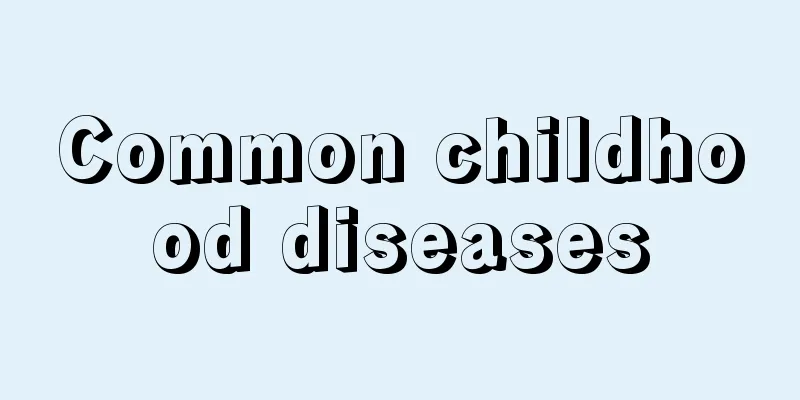Common childhood diseases

|
There are many types of common diseases in life, but for common diseases in children, the diseases they cause also change according to the seasons. So at this time, parents also need to pay attention to improving their children's diseases. When treating some diseases of children, you cannot choose treatment methods at will. You must first understand the disease so that you can be more relaxed when treating it. So what are the common childhood diseases? The following is a detailed introduction so that parents can have some understanding and take preventive measures in different seasons to prevent their children from suffering from such diseases and causing damage to their health. Common diseases in children: Common childhood diseases in spring Everything seems full of life in spring, but it is indeed one of the peak seasons for babies to get sick. 1. The more common one is epidemic meningitis, also known as "meningococcal meningitis", which is highly contagious and has a particularly high incidence rate in children under 6 years old. Meningococcal disease has obvious seasonality, with the peak incidence in March and April. The incubation period is usually 2-3 days, but can be as long as 1 week. 2. Rubella is mostly caused by direct contact between babies and sick children. 3. Babies with allergic constitutions are prone to asthma, dermatitis, conjunctivitis and rhinitis, etc. Allergic asthma is caused by spring pollen mixed in the air, which enters the body through the nose and causes "spring allergies." 4. Influenza and mumps are prevalent in spring. Mumps, also known as "mumps", has a peak incidence in spring. 5. Measles. Once cured, the patient is immune for life. Measles is most common in winter and spring. 6. Scarlet fever is an acute rash-causing infectious disease that is most common in late winter and early spring. Scarlet fever can occur in any age group, but is most common in children aged 2-10 years. Common childhood diseases in summer The high temperature in summer and the hot weather can easily cause children to get sick. Common diseases in children in summer include: 1. Diarrhea. Children are prone to diarrhea in summer because they want to stay cool or eat spoiled food due to high temperatures. Especially from June to September, its incidence accounts for about 70% of the annual dysentery incidence. 2. Indigestion. There are many reasons for indigestion. In addition to hygiene, eating habits and other reasons, it is worth noting that in functional diseases of the digestive tract, the role of mental factors has occupied an important position in its pathogenesis. 3. Enteritis. Enteritis refers to acute or chronic inflammation of the intestinal mucosa. Enteritis is a general term for inflammation of the stomach, small intestine and colon. Common childhood diseases in autumn Common diseases among children in autumn include: In autumn, babies are prone to diseases due to temperature changes and environmental changes. Common diseases include diarrhea, asthma, allergic rhinitis, skin allergies, acute nephritis, etc. Diarrhea is the most common digestive system disease in children. Asthma often occurs in late summer and early autumn each year, reaching its peak from September to November and then subsiding after winter. The weather in autumn is dry, and various allergic factors may irritate children's nasal mucosa and cause allergic rhinitis. Common childhood diseases in winter Winter is the peak season for diseases among children, the most common of which is angular cheilitis. The air in winter is dry, cold and windy, and the lips become uncomfortable due to dryness, resulting in dry and cracked skin on the lips and corners of the mouth. Therefore, when children have dry and uncomfortable lips, parents should apply oily skin care products to them and remind them not to lick the affected area with their tongues. The second is dry and cracked skin or frostbite. Children's lips and skin will be drier in dry and cold weather, and in severe cases, cracking and bleeding may occur. At this time, you can apply oily ointment appropriately to keep it moist. Hand, foot and mouth disease is also one of the most common diseases among children in winter. Hand, foot and mouth disease is more common in children under 6 years old, especially infants under 3 years old. It is mainly transmitted through close contact between people. The above is a detailed introduction to common childhood diseases. These diseases are very easy for children to suffer from. When treating these diseases, medication is the best choice. However, for some infectious diseases, such as hand, foot and mouth disease, it is contagious. When children suffer from it, they must be treated in a timely manner. |
>>: Treatment of pneumonia in children
Recommend
What should I do if my 1-year-old baby has a cold and fever?
Because babies are young, they will feel uncomfor...
What should I do if my baby who just turned one month old doesn't poop?
For newborn babies, since the functions of variou...
White spots in the child's eyes
If there are white spots in a child's eyes, i...
What cures cough for children?
Every spring and winter are the seasons when peop...
What should I do if my newborn chokes on milk due to pneumonia?
How should pneumonia be treated? How should neona...
Can children eat mung bean porridge?
Can children eat mung bean porridge? Mung bean po...
What are the reasons why babies have difficulty falling asleep?
Baby sleeping is a problem that many mothers worr...
Why do babies like to touch their ears?
Babies usually like to touch their ears. This is ...
How to correct children's hunchbacks? Parents need to pay attention
If a child has a hunchback, parents should prompt...
Baby coughs and phlegm, what should I eat to get better quickly
In today's social life, the birth of every ba...
3-year-old baby with bronchitis and cough
Nowadays, more and more people are suffering from...
How to treat children’s allergic cough with traditional Chinese medicine?
Because children are young and have very poor phy...
The 40-day-old baby has a swollen belly?
For new parents, when the baby has a bulging bell...
What are the symptoms of UV allergy in babies?
Children's skin is relatively delicate, so th...
If a child has tooth decay pain, distinguish the severity and then treat it
Children love candy, so tooth decay is a common p...









